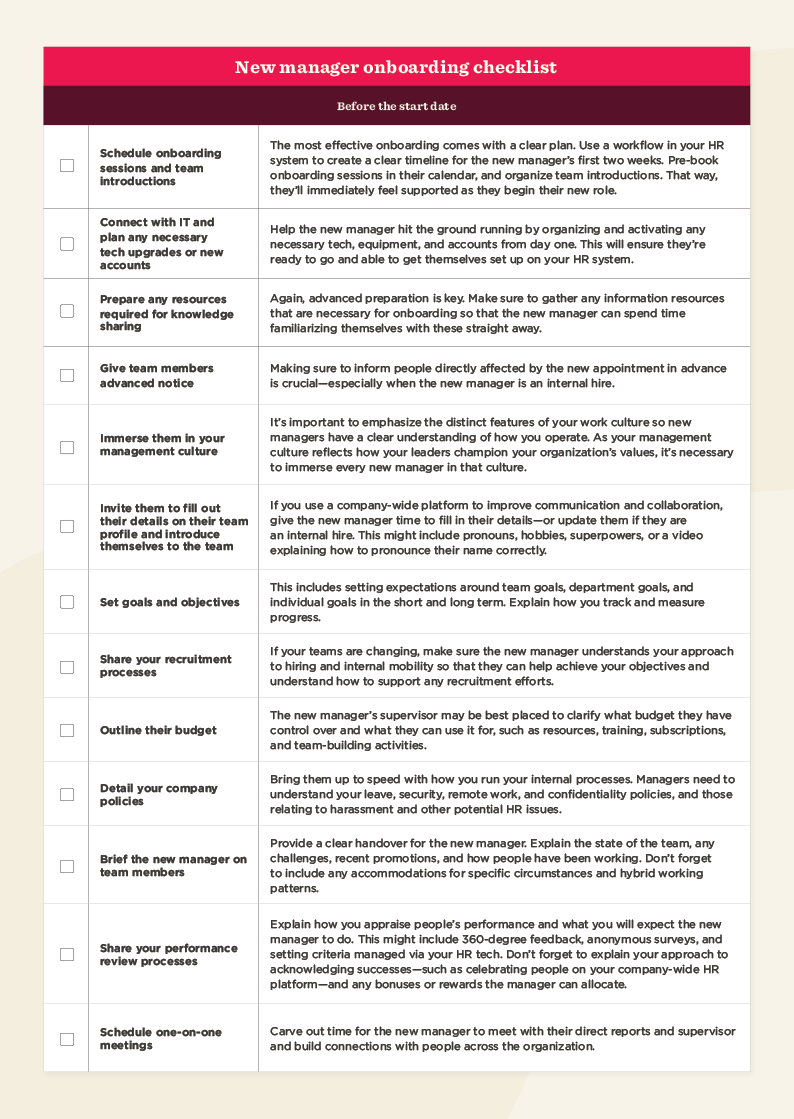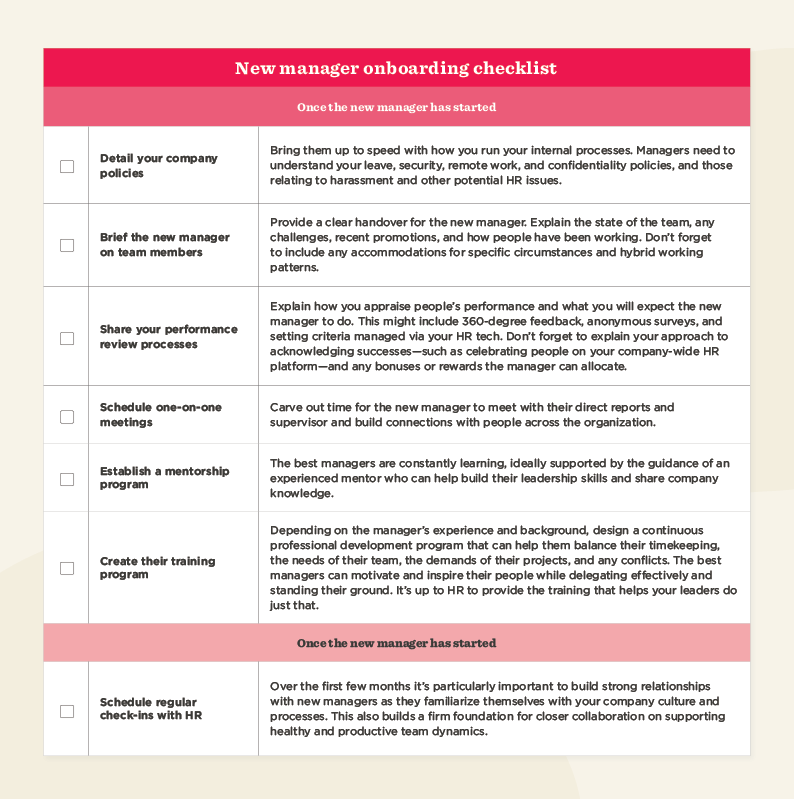Managers are the beating heart of an effective organization.
The responsibility for your teams’ productivity and ability to deliver against company objectives rests on their shoulders.
Line managers work directly with your people, driving company culture and working endlessly to keep team members engaged, fulfilled, and motivated. Organizations thrive when managers perform well, meet goals, and succeed.
That’s why helping your managers to do an excellent job is one of the most critical responsibilities of HR professionals—and it all starts with onboarding.
If your new manager is an external hire, chances are that your standard onboarding checklist will cover the majority of their basic needs. But getting new leaders ready for people management responsibilities—especially when they’re an internal recruit—is a completely different beast. It calls for a tailored new manager checklist to make sure you’re providing incoming managers with the right level of support and training.
This new manager onboarding checklist can help you develop the next generation of talented people leaders in your organization so that you can continue to build strong, agile, productive teams who drive your business forward and help you achieve your strategic objectives.

How to onboard new managers
The way you approach onboarding a new manager depends on whether they are an external hire or a promoted internal team member.
For the former, much of your usual new joiner onboarding process will apply, with key differences that relate to their ability to manage those under them. For internal hires, while there is likely to be less practical onboarding required in terms of technical equipment, personal information gathering, and familiarization with company policies, the onboarding process should still be in-depth, with skills development and ongoing training.
You’ll find a thorough manager onboarding checklist later on in this guide, but in the meantime, here’s how you might go about your new manager orientation:
- Plan your key milestones and action steps, and put a realistic timeline against them
- Make a list of all the key information the new manager will need—and gather it
- Schedule introductions and check-ins with all their key connections, such as their direct reports and line manager
- Lay the groundwork for a continuous learning program, and consider providing mentorship and leadership-building training
- Complete all the usual HR onboarding steps such as team integration, company induction, and health and safety training
- Set goals and expectations, and provide opportunities for the new manager to reconnect with HR and take stock
If you’re in a hurry, you can take a look through our example onboarding templates, to help you get a plan in place.

Best practices for onboarding new managers
The “5 Cs” is a powerful established framework to consider when building an onboarding plan for new managers, and it covers many best practices. It outlines the key areas of engagement required as you induct a new manager into the business.
Here’s how it works:
- Compliance. This is the first step in onboarding managers, typically carried out by a member of the HR team to cover everything from company policies, health and safety regulations, confidentiality needs, and any relevant departmental procedures. IT representatives will also set up the new manager with their computer, managerial permissions and access, email account, and any other technology and logins required. Although you may not need to do all of this for internal hires, it’s important to consider how their relationship with some of your key company policies may differ once they are responsible for other professionals.
- Clarification. This area of onboarding is all about setting goals and performance expectations. Once you induct a new manager into the organization’s wider strategy, it might be appropriate to establish clear individual and team goals and to set a timeline for each. This is a great way of giving the manager a space to ask questions and get a clear understanding of what the company expects of them.
- Culture. Even an external hire will likely have some appreciation of your company culture from the application and interview process. But as a leader, they will need to learn how to live and enact that culture every day. Your company’s mission, values, and history can be a great place to start and explain how team members typically communicate and socialize.
- Connection. Interpersonal relationships are essential for smooth knowledge sharing at work, and people managers will need to strike up a rapport with their teams as early as possible. Introducing new colleagues and team members to one another, updating people when someone has changed roles, and even assigning a mentor can be great ways of helping a new manager settle in fast.
- Check back in. Checking back in helps you and the new manager ensure their onboarding is going smoothly and that they are settling into their role. Establishing regular reflection meetings at the 30-, 60-, and 90-day milestones can be a great way of keeping an eye on progress and helping address any issues as required.

Why is having a new manager onboarding program important?
Most professionals want to get promoted at some time or another, and many of those people are exceptional performers at work.
However, taking on more responsibilities and leading projects is different from being a good people manager, which requires a unique set of skills.
Effective people management requires emotional intelligence, diplomacy, and the ability to balance the technical demands of the job with the need to avoid burnout and keep the team happy and healthy.
Managers are a crucial part of your organization, and as the saying goes, “People leave bad managers, not bad jobs.” This means that helping your managers become the best people leaders they can be—by giving them the right connections, tools, and training—is an essential HR responsibility.
A bespoke manager onboarding program—supported by a new supervisor training checklist—is the best way to do that, as it covers all the knowledge sharing, relationship building, and ongoing training required to help your managers become better leaders.

What’s the difference between onboarding new managers and onboarding employees?
On a practical level, there are several key differences between what a new manager and a new team member may require during onboarding. A new manager, for example, may need:
- An introduction to specific employment policies and how to implement these in practice
- An introduction to the company’s feedback and appraisal system
- An understanding of their responsibilities to their team and their freedom (or otherwise) to approve time off or distribute bonuses
- An introduction to a wider range of people at different levels of the organization
On a deeper level, people managers also need to balance deadlines and the practical elements of project delivery with the softer skills of managing people and looking after their team.
HR professionals are well placed to support managers in carrying out those tasks with leadership onboarding—providing training, mentorship, and check-ins.

The importance of leadership training programs
What does good leadership look like at work?
While your mind might land on particular managers you’ve most enjoyed working with, effective leadership comes in many different styles and forms. After all, there are a variety of ways to build high-performing, motivated teams.
That makes it HR’s responsibility to identify high-potential team members at all levels of the organization and to spot the next generation of management talent. Someone with emotional intelligence who knows how to deal with people and can say no—protecting their team from burnout rather than being an appeaser—has many of the raw talents needed to become an excellent people leader.
Leadership training programs are the way to hone those talents into concrete skills that can drive teams forward. Given the importance of effective leaders, creating those programs is one of the most influential things HR professionals can do.
The best leadership training programs use mentorship and coaching with high-performing managers to help new leaders absorb skills and discover various approaches. While a learning management system (LMS) is also vital, training is even more effective when combined with in-person experience.
With an effective training program, you can nurture managers into some of your best communicators: able to give and generate trust and respond flexibly to the complex demands of people’s jobs.
In a genuinely people-focused organization, managers need to take the time to understand the broader context of team members’ complex and often challenging lives, supporting them with care, resourcing, and thoughtfulness. After all, working together, sharing the load, and supporting each other are the key ingredients needed to build truly agile and resilient teams.
By working closely with managers, holding open conversations, and carrying out effective management onboarding, HR professionals can also help nurture an environment that will ultimately deliver better business results.

Your onboarding checklist for new managers
<<Download our free onboarding checklist for new managers.>>
Next steps: Tracking manager success with HR tech
Now that your new leader is in their role and you’ve followed your onboarding guide for managers, what next?
HR tech can help you guide them in the right direction as you carry out the following tasks:

Analyzing new manager success
HR tech can help you analyze the success of your new manager by monitoring measurable goals and targets and gathering feedback from their team and supervisor.
This is especially important over the first 30, 60, and 90 days of them being in their new post when you want to be sure that they are settling in and embracing your company culture.
Customizing for different types of managers
The best HR tech allows you to customize your onboarding workflows according to different categories. That means you can create distinct strategies for people managers, team leaders, project managers, and senior professionals with creative or delivery oversight.
Tracking performance and goals over time
Organizations of every size struggle to identify trends without the right software. HR tech makes it easy to see what’s happening by letting you customize dashboards and track changes in performance and goal achievement over different time frames.
Recommended For Further Reading
Syncing with your LMS
Finally, it’s important to consider new manager onboarding and leadership training as an ongoing, continuous process. Syncing their learning with your LMS, right inside your HR tech, is a powerful way of providing consistent support and monitoring the development of your leaders. With everything connected to one central hub, you can avoid time-consuming switching between different software packages and various complicated login credentials.
Building future people leaders
Being a people manager takes something special, and manager onboarding deserves its own distinct process.
With Generation Z set to account for 27 percent of the workforce by 2025, it’s clear that leadership styles will need to evolve—just as HR and business strategies need to change with the times.
Managers need to be agile and flexible. And more than anything, they need to be able to handle the responsibility of balancing processes and admin duties with caring for their people. HR’s responsibility rests with developing manager onboarding programs into ongoing support initiatives designed to help leaders be remarkable people managers.
Providing training in managerial techniques as part of a professional education program is the best way to build the effective teams of tomorrow. By collaborating closely with your people, HR professionals can make the difference between an ineffective and exceptional manager.



